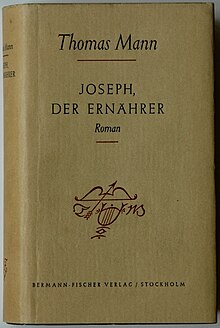Joseph and his Brothers

Cover of the first edition of part 4 (1943)
|
|
| Author | Thomas Mann |
|---|---|
| Original title | Joseph und seine Brüder |
| Country | Germany |
|
Publication date
|
1943 |
| Media type | Book |
Joseph and His Brothers (Joseph und seine Brüder) is a four-part novel by Thomas Mann, written over the course of 16 years. Mann retells the familiar stories of Genesis, from Jacob to Joseph (chapters 27–50), setting it in the historical context of the Amarna Period. Mann considered it his greatest work.
The tetralogy consists of:
Mann's presentation of the Ancient Orient and the origins of Judaism is influenced by Alfred Jeremias' 1904 Das Alte Testament im Lichte des Alten Orients, emphasizing Babylonian influence in the editing of Genesis, and by the work of Dmitry Merezhkovsky.
Mann sets the story in the 14th century BC and makes Akhenaten the pharaoh who appoints Joseph his vice-regent. Joseph is aged 28 at the ascension of Akhenaten, which would mean he was born about 1380 BC in standard Egyptian chronology, and Jacob in the mid-1420s BC. Other contemporary rulers mentioned include Tushratta and Suppiluliuma.
A dominant topic of the novel is Mann's exploration of the status of mythology and his presentation of the Late Bronze Age mindset with regard to mythical truths and the emergence of monotheism. Events of the story of Genesis are frequently associated and identified with other mythic topics.
Central is the notion of underworld and the mythical descent to the underworld. Jacob's sojourn in Mesopotamia (hiding from the wrath of Esau) is paralleled with Joseph's life in Egypt (exiled by the jealousy of his brothers), and on a smaller scale his captivity in the well; they are further identified with the "hellraid" of Inanna-Ishtar-Demeter, the Mesopotamian Tammuz myth, the Jewish Babylonian captivity as well as the Harrowing of Hell of Jesus Christ.
...
Wikipedia
